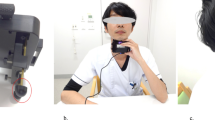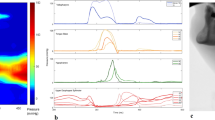Abstract
The aim of this study was to determine if bolus and dry swallow showed similar pressure changes in the oropharynx using our newly developed device. A unique character of it includes that baropressure can be measured with the sensor being placed in the balloon and can assess the swallowing mechanics in terms of pressure changes in the oropharynx with less influences of direct contacts of boluses and oropharyngeal structures during swallow indirectly. Fifteen healthy subjects swallowed saliva (dry), 15 ml of water, 45 ml of water, and 15 ml of two different types of food in terms of viscosity (potage soup-type and mayonnaise-type foods). Suprahyoid muscle activity was recorded simultaneously. Three parameters, area under the curve (AUC), peak amplitude, and duration of pressure, were analyzed from each swallow. Almost all of the bolus swallowing events had biphasic baropressure responses consisting of an early phase and late phase (99%), whereas 90% of the saliva swallowing events had a single phase. AUC, peak, and duration displayed greater effects during the late phase than during the early phase. Baropressure of the early phase, but not of the late phase, significantly increased with increasing volume; however, small but significant viscosity effects on pressure were seen during both phases. Peak pressure of the late phase was preceded by maximum muscle activity, whereas that of the early phase was seen when muscle activity displayed a peak response. These findings indicated that our device with the ability to measure baropressure has the potential to provide additional parameter to assess the swallow physiology, and biphasic baropressure responses in the early and late phases could reflect functional aspects of the swallowing reflexes.





Similar content being viewed by others
References
Salassa JR, DeVault KR, McConnel FM. Proposed catheter standards for pharyngeal manofluorography (videomanometry). Dysphagia. 1998;13:105–10.
Pitts T. Airway protective mechanisms. Lung. 2014;192:27–31.
Kuo P, Holloway RH, Nguyen NQ. Current and future techniques in the evaluation of dysphagia. J Gastroenterol Hepatol. 2012;27:873–81.
Huckabee ML, Butler SG, Barclay M, Jit S. Submental surface electromyographic measurement and pharyngeal pressures during normal and effortful swallowing. Arch Phys Med Rehabil. 2005;86:2144–9.
Omari TI, Rommel N, Szczesniak MM, Fuentealba S, Dinning PG, Davidson GP, Cook IJ. Assessment of intraluminal impedance for the detection of pharyngeal bolus flow during swallowing in healthy adults. Am J Physiol Gastrointest Liver Physiol. 2006;290:G183–8.
Al-Toubi AK, Doeltgen SH, Daniels SK, Corey DM, Huckabee ML. Pharyngeal pressure differences between four types of swallowing in healthy participants. Physiol Behav. 2015;140:132–8.
Kendall KA, McKenzie S, Leonard RJ, Goncalves MI, Walker A. Timing of events in normal swallowing: a videofluoroscopic study. Dysphagia. 2000;15:74–83.
Yoon KJ, Park JH, Park JH, Jung IS. Videofluoroscopic and manometric evaluation of pharyngeal and upper esophageal sphincter function during swallowing. J Neurogastroenterol Motil. 2014;20:352–61.
Yano J, Aoyagi Y, Ono T, Hori K, Yamaguchi W, Fujiwara S, Kumakura I, Minagi S, Tsubahara A. Sequential coordination between lingual and pharyngeal pressures produced during dry swallowing. Biomed Res Int. 2014;2014:691352.
Perlman AL, Schultz JG, VanDaele DJ. Effects of age, gender, bolus volume, and bolus viscosity on oropharyngeal pressure during swallowing. J Appl Physiol. 1985;75(33–37):1993.
Gumbley F, Huckabee ML, Doeltgen SH, Witte U, Moran C. Effects of bolus volume on pharyngeal contact pressure during normal swallowing. Dysphagia. 2008;23:280–5.
Fox MR, Bredenoord AJ. Oesophageal high-resolution manometry: moving from research into clinical practice. Gut. 2008;57:405–23.
Kahrilas PJ, Sifrim D. High-resolution manometry and impedance-pH/manometry: valuable tools in clinical and investigational esophagology. Gastroenterology. 2008;135:756–69.
Ryu JS, Park DH, Kang JY. Application and interpretation of high-resolution manometry for pharyngeal dysphagia. J Neurogastroenterol Motil. 2015;21:283–7.
Castell JA, Dalton CB, Castell DO. Pharyngeal and upper esophageal sphincter manometry in humans. Am J Physiol. 1990;258:G173–8.
Butler SG, Stuart A, Castell D, Russell GB, Koch K, Kemp S. Effects of age, gender, bolus condition, viscosity, and volume on pharyngeal and upper esophageal sphincter pressure and temporal measurements during swallowing. J Speech Lang Hear Res. 2009;52:240–53.
Hiraki K, Yamada Y, Kurose M, Ofusa W, Sugiyama T, Ishida R. Application of a barometer for assessment of oral functions: donders space. J Oral Rehabil. 2017;44:65–72.
Otake M, Kurose M, Uchida Y, Hasegawa M, Yamada Y, Saito I, Yamamura K. The interactions between different tastes on initiation of reflex swallow elicited by electrical stimulation in humans. Odontology the Society of the Nippon Dental University, 2015.
Donner MW, Bosma JF, Robertson DL. Anatomy and physiology of the pharynx. Gastrointest Radiol. 1985;10:196–212.
Kahrilas PJ, Lin S, Logemann JA, Ergun GA, Facchini F. Deglutitive tongue action: volume accommodation and bolus propulsion. Gastroenterology. 1993;104:152–62.
Dodds WJ, Hogan WJ, Lydon SB, Stewart ET, Stef JJ, Arndorfer RC. Quantitation of pharyngeal motor function in normal human subjects. J Appl Physiol. 1975;39:692–6.
Cerenko D, McConnel FM, Jackson RT. Quantitative assessment of pharyngeal bolus driving forces. Otolaryngol Head Neck Surg. 1989;100:57–63.
Lin T, Xu G, Dou Z, Lan Y, Yu F, Jiang L. Effect of bolus volume on pharyngeal swallowing assessed by high-resolution manometry. Physiol Behav. 2014;128:46–51.
Omari TI, Dejaeger E, Tack J, Van Beckevoort D, Rommel N. Effect of bolus volume and viscosity on pharyngeal automated impedance manometry variables derived for broad dysphagia patients. Dysphagia. 2013;28:146–52.
McConnel FM. Analysis of pressure generation and bolus transit during pharyngeal swallowing. Laryngoscope. 1988;98:71–8.
Raut VV, McKee GJ, Johnston BT. Effect of bolus consistency on swallowing–does altering consistency help? Eur Arch Otorhinolaryngol. 2001;258:49–53.
Okada A, Honma M, Nomura S, Yamada Y. Oral behavior from food intake until terminal swallow. Physiol Behav. 2007;90:172–9.
Taniguchi H, Tsukada T, Ootaki S, Yamada Y, Inoue M. Correspondence between food consistency and suprahyoid muscle activity, tongue pressure, and bolus transit times during the oropharyngeal phase of swallowing. J Appl Physiol. 1985;105(791–799):2008.
Hiiemae KM, Palmer JB. Food transport and bolus formation during complete feeding sequences on foods of different initial consistency. Dysphagia. 1999;14:31–42.
Acknowledgements
This work was supported by JSPS KAKENHI [Grant Number JP15K11055]. We would like to thank Editage (www.editage.jp) for English language editing. We are grateful to Prof. Takahiro Ono (Niigata University) for their discussion and helpful comments.
Author information
Authors and Affiliations
Corresponding author
Ethics declarations
Conflict of interest
The authors declare that they have no conflicts of interest.
Rights and permissions
About this article
Cite this article
Hasegawa, M., Kurose, M., Okamoto, K. et al. Differential Response Pattern of Oropharyngeal Pressure by Bolus and Dry Swallows. Dysphagia 33, 83–90 (2018). https://doi.org/10.1007/s00455-017-9836-9
Received:
Accepted:
Published:
Issue Date:
DOI: https://doi.org/10.1007/s00455-017-9836-9




